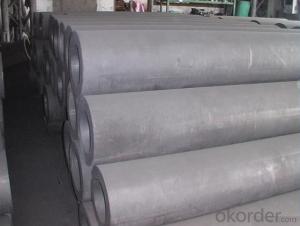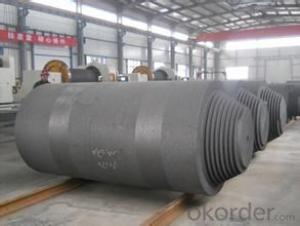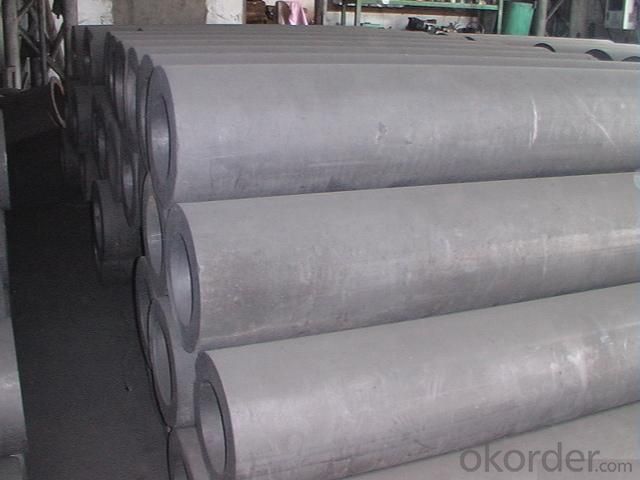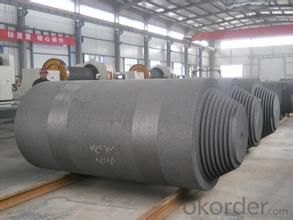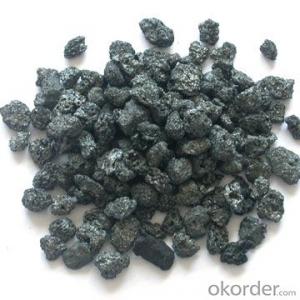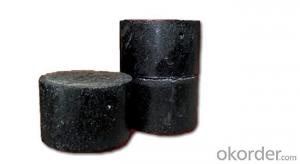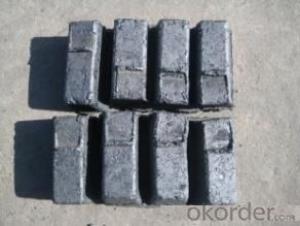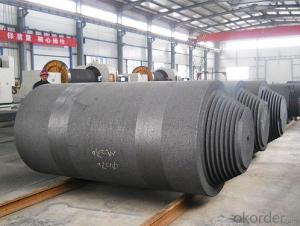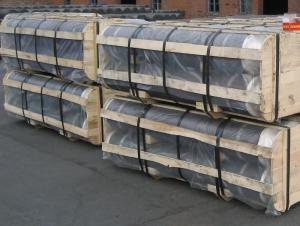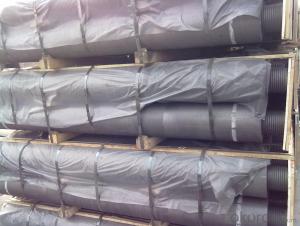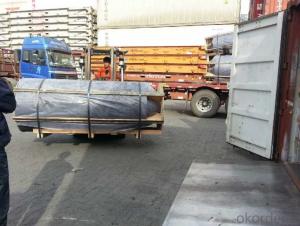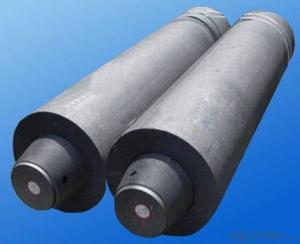Carbon Electrode With Φ500~Φ700 S Grade
- Loading Port:
- Tianjin
- Payment Terms:
- TT OR LC
- Min Order Qty:
- 20 m.t.
- Supply Capability:
- 800 m.t./month
OKorder Service Pledge
OKorder Financial Service
You Might Also Like
Carbon Electrode With Φ500~Φ700 S Grade
Product Description
Carbon Electrode is abaked electrode used in submerged arc furnaces for delivering power to the charge mix. Electrode is added to the top of the electrode column cylindrical form. Electrode is essentially a mix of Electrically Calcined Anthracite (ECA) or Calcined Petroleum Coke (CPC) with Coal Tar Pitch and is baked for weeks, it is widly used for ferroally productiong, silicon metal production etc.
Features
1:carbon eletrode
2:for ferroalloy,calcium carbide, silicon metal, manufacture
Graphite/Carbon Electrode Paste Specification
| PARAMETER UNIT GUARANTEE VALUE | ||||||
| Items | Φ500~Φ700 | Φ750~Φ960 | Φ1020~Φ1400 | |||
| Rs μΩ.m | ≤45 | ≤38 | ≤45 | ≤38 | ≤40 | |
| Bulk Desity g/cm3 | ≥1.55 | ≥1.58 | ≥1.55 | ≥1.58 | ≥1.55 | ≥1.58 |
| Bending Strength MPa | 3.5~7.5 | 4.0~7.5 | 3.5~7.5 | 4.0~7.5 | 3.5~7.5 | 4.0~7.5 |
| Compressive Strength MPa | ≥20.0 | ≥20.0 | ≥20.0 | ≥20.0 | ≥19.0 | ≥19.0 |
| Compressive Strength MPa | 3.2~4.8 | 3.0~4.6 | 3.2~4.8 | 3.0~4.6 | 3.2~4.8 | 3.0~4.6 |
| Ash % | ≤2.5 | ≤2.0 | ≤2.5 | ≤2.0 | ≤2.5 | ≤2.0 |
Picture
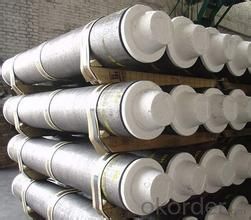
We Also supply all kind of carbon electrode paste and below materials, please contact us if you have any enquiry about it.
Calcined Anthracite
Calcined Petroleum Coke
Coke (Met Coke, Foundry Coke, Semi Coke)
- Q: How is carbon formed?
- Carbon is formed through various natural processes, primarily through the cycle of life and death of living organisms. The formation of carbon starts with the process of photosynthesis in plants, where they use sunlight, water, and carbon dioxide from the atmosphere to produce glucose. This glucose is then converted into other organic molecules, such as carbohydrates, fats, and proteins, which form the fundamental building blocks of all living organisms. When plants and animals die, their remains and waste products are broken down by decomposers like fungi and bacteria. During this decomposition process, carbon is released back into the environment in the form of carbon dioxide or methane gas. Additionally, some of the organic matter may become buried under layers of sediment, where it undergoes a process called fossilization over millions of years. This fossilization process, combined with heat and pressure, transforms the organic matter into fossil fuels such as coal, oil, and natural gas, which are rich sources of carbon. Apart from the biological processes, carbon can also form through geological processes. Volcanic eruptions release carbon dioxide into the atmosphere, and over long periods of time, this carbon dioxide can dissolve in water and combine with minerals to form rocks like limestone. These rocks act as a carbon sink, storing large amounts of carbon over geologic timescales. Overall, carbon is formed and cycled through a complex interplay of biological and geological processes, playing a crucial role in maintaining the balance of carbon in the Earth's atmosphere and supporting life as we know it.
- Q: What is the carbon content of 45# steel?
- Between 0.42- and zero point five zero percent per cent
- Q: How do you remove car carbon?
- 3, running high speed can flush carbon deposition? Running high speed, you can really use the airflow on the airway erosion, wash away part of the carbon deposition. So, if you happen to go out, there are high-speed, national road two choices, you may choose to pull back to speed. But, Ma director thinks, if be in order to "flush carbon deposit" specially, want to run high speed, do not have this necessity. "It is a waste of time, and the cost of oil, extra high speed tolls, the effect is better to do a maintenance 4S shop!" 4, improve the shift speed, such as the original speed 2000rpm shift, modified 2500rpm conversion, generated can prevent carbon deposition, but also to protect the engine? Ma director said, low speed the shift, is often said that the "drag block", the car is easy to knock, the combustion of gasoline is not sufficient to carbon deposition. But it's not necessary for people to increase gear speed - that will increase fuel consumption and cause premature wear of clutch friction plates. So, manual transmission of the car, 1.6 ~ 2.0L displacement, about 2000 rpm shift is more economical, and no need to improve; and automatic car, pay attention not to slam the gas.
- Q: What are the impacts of carbon emissions on the stability of river ecosystems?
- Carbon emissions have significant impacts on the stability of river ecosystems. Increased carbon dioxide levels in the atmosphere lead to global warming, which in turn affects river temperatures and alters the water cycle. These changes can disrupt the balance of river ecosystems, impacting the availability of oxygen, nutrient cycling, and the reproductive cycles of aquatic organisms. Additionally, carbon emissions contribute to ocean acidification, which can indirectly affect river ecosystems through changes in the food chain and the migration patterns of certain species. Overall, carbon emissions pose a threat to the stability and biodiversity of river ecosystems.
- Q: How does carbon impact the stability of ecosystems?
- Carbon impacts the stability of ecosystems in several ways. Firstly, carbon is a fundamental element that forms the basis of all organic compounds, including carbohydrates, proteins, and lipids, which are essential for the growth and survival of all living organisms. Carbon is cycled through various processes like photosynthesis and respiration, maintaining the energy flow within ecosystems. However, excessive carbon emissions, mainly through the burning of fossil fuels, contribute to the greenhouse effect and climate change. Rising carbon dioxide levels in the atmosphere lead to global warming, altering temperature and precipitation patterns. These changes can disrupt ecosystems, affecting the distribution and abundance of species, as well as their interactions. Additionally, carbon is a vital component of soil organic matter, which enhances soil fertility, water-holding capacity, and nutrient availability. Deforestation and land degradation, often driven by human activities, release large amounts of carbon into the atmosphere and reduce the carbon storage capacity of ecosystems. This can lead to decreased soil productivity, loss of biodiversity, and increased vulnerability to erosion and drought. Therefore, managing carbon emissions, promoting sustainable land use practices, and preserving natural habitats are crucial for maintaining the stability and resilience of ecosystems.
- Q: What is the thickness of carbon fiber heating?
- The hair line is 4-5mm, and here is the 2CM thermal insulation board. It's only 2.4,2.5 of the total. You can go to Ji'nan emperor long carbon fiber to see, they have a full product and reliable quality.Please accept the answer and support me.
- Q: What are the effects of carbon emissions on the stability of grasslands?
- Carbon emissions have a significant impact on the stability of grasslands. One of the main effects is the alteration of the climate, specifically through the greenhouse effect. Carbon dioxide (CO2) is a major greenhouse gas, and the increased concentration of CO2 in the atmosphere leads to global warming. This rise in temperature affects grasslands by altering their natural growth patterns and disrupting the delicate balance of their ecosystems. Higher temperatures caused by carbon emissions can lead to increased evaporation rates, resulting in drier soil conditions. Grasslands are adapted to specific moisture levels, and any changes in these conditions can lead to reduced plant growth and increased susceptibility to drought. As a consequence, grasslands become less stable and more prone to desertification. Moreover, elevated levels of carbon dioxide can affect the nutritional quality of grasses. As CO2 concentrations increase, the relative proportion of essential nutrients in grasses may decrease. This phenomenon, known as nutrient dilution, can impact the health and productivity of herbivores that rely on these grasslands for sustenance. The decline in nutritional value can disrupt the delicate balance of predator-prey relationships and lead to a decline in biodiversity. Additionally, carbon emissions contribute to the acidification of soils. Increased carbon dioxide dissolves in rainwater, forming carbonic acid, which lowers the pH of the soil. Grasses are sensitive to changes in soil pH, and acidification can negatively affect their growth and nutrient uptake. Acidic soil conditions can also lead to the loss of important microorganisms that contribute to a healthy soil ecosystem, further destabilizing grasslands. Lastly, carbon emissions have indirect effects on grasslands through climate change-induced alterations in precipitation patterns. Changes in rainfall patterns can lead to shifts in plant composition and distribution, favoring invasive species or altering the competitive balance between different grass species. This can disrupt the stability and functioning of grassland ecosystems. In conclusion, carbon emissions have numerous detrimental effects on the stability of grasslands. These include changes in climate, increased vulnerability to drought, nutrient dilution, soil acidification, and alterations in precipitation patterns. It is crucial to reduce carbon emissions and mitigate the impacts of climate change to preserve the stability and integrity of grassland ecosystems.
- Q: What should I do when carbon monoxide leaks?
- Be careful not to let their affected by the cold, otherwise, may make the body temperature decreased cardiac arrest. If the poisoned person can drink, can feed the hot tea and sugar, to keep warm, cold towel head can not be used, but can not pour cold water. Poisoning breathing difficulties or just stop breathing, artificial respiration should be immediately closed chest cardiac massage or first aid, and to call the ambulance the unit, or ask the neighbors to help, send the patient to the hospital for treatment.
- Q: How to extinguish the charcoal fire?
- Charcoal air on the line, but also can use water, but there will be a lot of gases
- Q: Can carbon in barbecue cause cancer? Can carbonated food cause cancer?
- At the same time, there is another carcinogen in the barbecue food - nitrosamines.Why not eat barbecue food, mainly because of its high fat content, not health, but also not easy to digest, in addition, because the stall in the barbecue grill to add spices and other things, therefore, the body fat intake will cause degeneration in vivo, which leads to the occurrence of cancer.
Send your message to us
Carbon Electrode With Φ500~Φ700 S Grade
- Loading Port:
- Tianjin
- Payment Terms:
- TT OR LC
- Min Order Qty:
- 20 m.t.
- Supply Capability:
- 800 m.t./month
OKorder Service Pledge
OKorder Financial Service
Similar products
Hot products
Hot Searches
